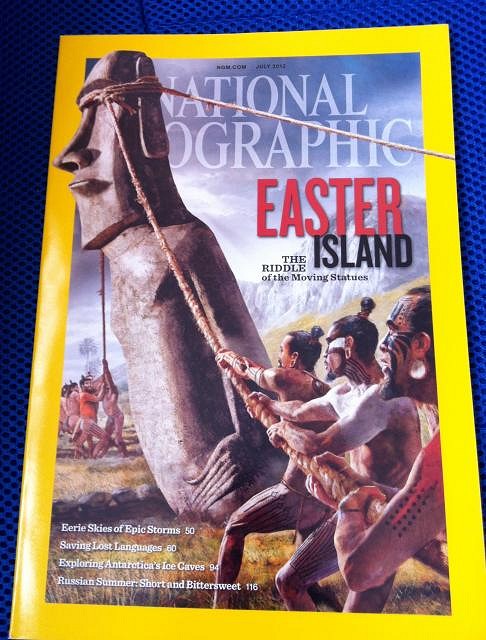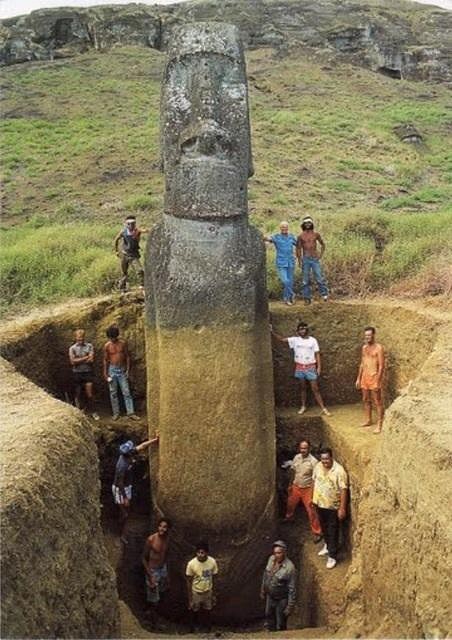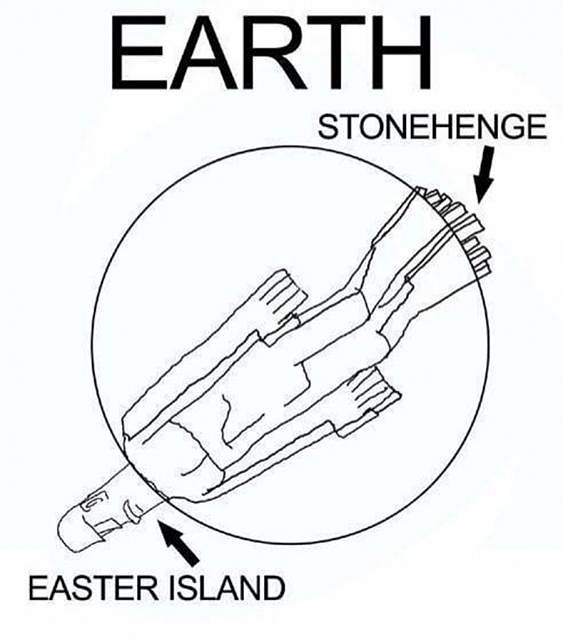Tiki Central / General Tiki
Moai, ,July National Geographic
Pages: 1 16 replies
|
N''
nui 'umi 'umi
Posted
posted
on
Mon, Jun 18, 2012 6:46 PM
Nice article-theorie's on how the Moai moved from the quarry to ? [ Edited by: nui 'umi 'umi 2012-06-18 18:48 ] |
|
T
TikiTech
Posted
posted
on
Mon, Jun 18, 2012 9:22 PM
Here's the magazine: |
|
N''
nui 'umi 'umi
Posted
posted
on
Mon, Jun 18, 2012 9:39 PM
Mahalo Tiki Tech for posting the pic. Someday I'll figure out how. |
|
H
hiltiki
Posted
posted
on
Thu, Jun 21, 2012 10:13 AM
|
|
A

AceExplorer
Posted
posted
on
Thu, Jun 21, 2012 11:47 AM
I read this and also yesterday's LA Times article. Whew, I can only imagine the stress involved in "waddling" a 90-ton statue down ancient dirt roads. The risk involved in making even a tiny mistake moving huge statues in that manner is insane, especially when you consider the effort involved in first carving such large statues. You don't want to make a mistake at any point. So as a casual reader I'm finding myself a bit skeptical of the "waddling" theory. But who knows - ancient man has proven time and again that they were not only creative, but accurate and effective as well. It's too bad that there isn't a cave somewhere on Rapa Nui with carving and installation diagrams carved on a wall. Or how about a "pit of rejects and mistakes" somewhere as well. Did these guys make any throwaway "practice" statues anywhere, and if they did, where are they now? It would be fun to visit the island and see the quarries and ask local onsite "experts" about things which the news stories never talk about. |
|
T
teaKEY
Posted
posted
on
Thu, Jun 21, 2012 1:54 PM
Did these guys make any throwaway "practice" statues anywhere, and if they did, where are they now? There are 900+ Moai on the island and only a handful have made it to the alter. They are all along the road. |
|
A

AceExplorer
Posted
posted
on
Thu, Jun 21, 2012 8:27 PM
Interesting... So if only a handful made it to the big pedestal or "altar," then perhaps the rest were set up as sentinels of sorts? Or, maybe the "waddling" of the moai didn't work out well and therefore we see today a fairly random placement of the majority? I figure that they had very weak and poorly-made ropes back in their time, and waddling the statues across the islands was very risky, and use of logs much safer and more practical. Ok, all of this is pure wild-assed speculation on my part. Guess I should just read up on it all elsewhere, ha... Gotta hand it to those native people, though, their very stylized carvings sure do look very cool these days. |
|
C
christiki295
Posted
posted
on
Thu, Jun 21, 2012 10:59 PM
LA TIMES By Thomas H. Maugh II Most everyone is familiar with the enigmatic stone heads of Easter Island, the massive carved rocks that sit on stone platforms on the coast and lie scattered across the landscape. The heads, called moai, and a small native population are virtually all that is left of the Polynesian civilization that once flourished on the island. The once-lush forests that covered the 63-square-mile island, known to its inhabitants as Rapa Nui, have all been lost and the fertile soil that once supported a vital farming community has been blown away by tradewinds. Something else has been left behind: two great mysteries. How did the islanders manage to transfer the massive heads, some weighing as much as 80 tons, from the quarries to the shore, and what happened to the forests? This month's National Geographic magazine examines the two competing theories for each of those questions. UCLA anthropologist Jared Diamond famously detailed what the called the "ecocide" of Rapa Nui in his 2005 book "Collapse." When Polynesians first settled the island about AD 800, they had the misfortune to select one that was dry, cool and remote -- and thus poorly fertilized by windblown dust or volcanic ash. They chopped down forests to provide wood for construction and for moving the moai, and the trees didn't return. The denuded landscape allowed winds to blow off the topsoil, and fertility fell sharply. When the natives no longer had wood for building fishing canoes, they killed and ate all the birds. Before the Dutch arrived at the island on Easter Sunday in 1722, the population had descended into cannibalism and barbarity. Diamond called it "the clearest example of a society that destroyed itself by over-exploiting its own resources." But archaeologists Carl Lipo of Cal State Long Beach and Terry Hunt of the University of Hawaii have a different take on the events based on more recent research. They agree that the island was an ecological disaster, but argue that the inhabitants share a smaller portion of the blame. Their research indicates that the Polynesian settlers did not arrive at Rapa Nui until about AD 1200, which would not leave nearly enough time to devastate the forests solely by slashing and burning. Unfortunately, the settlers brought Polynesian rats with them. The first inhabitants dined on the rats, but the animals had no other natural predators and overran the island. Buried nuts from the extinct Easter Island palms show distinctive teethmarks from the rats. They probably also ate birds' eggs. With the rats eating the palm nuts, the trees could not be reseeded naturally, Lipo and Hunt argue in their recent book, "The Statues That Walked," and the forests disappeared. The stone for the moai came from a quarry at Rano Raraku, the island's southeastern (extinct) volcano, several miles from the coast. Diamond and others have argued that the inhabitants put the moai on wooden sledges and dragged them to the shore on wooden rails -- an effort that would have required both large amounts of labor and massive quantities of wood. Last year, however, Hunt and Lipo showed that the stones could be "walked" by as few as 18 people with ropes by tilting them back and forth on their bases. That version jibes well with the islanders' own mythology, which claims that the moai walked across the island. The island is now a part of Chile and its 5,000 inhabitants are vastly outnumbered by the 50,000 tourists who visit each year. All food, fuel and other necessities have to be flown or shipped in, and water supplies are growing scarce. Residents worry about the future and how long the economy can survive in its present condition. The past is grim. The future might be grimmer. |
|
T

TravnerRavenweird
Posted
posted
on
Fri, Jun 22, 2012 8:22 AM
As someone who is reading his $1.00, Public Library purged copy of Aku Aku, I literally just read the part where the Islanders were explaining to the expedition members that the Moai "walked" to their spots on the beach and the team was kicking around the concept and figuring it out. |
|
C
christiki295
Posted
posted
on
Tue, Jun 26, 2012 12:16 AM
Great article! |
|
RB
Rum Balls
Posted
posted
on
Fri, Jun 29, 2012 6:30 AM
Read the story while at the dentist yesterday (hey, a NEW magazine in the lobby!)...fascinating, and of course, amazing photography. You can read & see it online, including a video animation of how the statues may have been moved: http://ngm.nationalgeographic.com/2012/07/easter-island/bloch-text |
|
W
woofmutt
Posted
posted
on
Wed, Aug 8, 2012 7:30 PM
Terry Hunt was on Coast to Coast AM with George Noory last night (8/7/12). I hadn't seen this thread or heard of his book The Statues that Walked: Unraveling the Mystery of Easter Island. It was really interesting (I like hearing hard science on a show usually more focussed on UFOs, ghosts, and conspiracy theories about ghost UFOs). Coast to Coast AM has an 800 number to call the show so I figured I should try to get on air and clarify a few points***** plus mention Tiki fans and, of course, Tiki Central. And I did. You can only hear past broadcasts of the show if you're a paid subscriber but in some markets they rebroadcast segments the following night or on weekends. (If you hear/heard me I'm "Dave" from Eastern Washington. "Dave" is my radio name. And my fast food name.) *****I'm not an expert but there were a couple points I thought hadn't been addressed fully. |
|
C
christiki295
Posted
posted
on
Fri, Aug 17, 2012 10:23 PM
Nice shout out. |
|
M
martian-tiki
Posted
posted
on
Thu, Oct 25, 2012 3:10 PM
http://www.nature.com/news/easter-island-statues-walked-out-of-quarry-1.11613 Easter Island statues 'walked' out of quarry A contentious theory is put to the test with an almost-life-size replica. (Website has a video) |
|
T
TikiTacky
Posted
posted
on
Sun, Jun 29, 2014 3:52 PM
This puts the "walking" Moai into a different light:
|
|
T
TikiTacky
Posted
posted
on
Sun, Jun 29, 2014 3:54 PM
Personally, I think this is the best theory: |
|
A

AceExplorer
Posted
posted
on
Sun, Jun 29, 2014 10:23 PM
Yeah, anything that tall must have been very unwieldy to "walk" anywhere. The risk of breaking a high percentage of finished moai was likely very high when using the "walking" technique with stone-age hand-made ropes. Of course, they seem to have exercised great care (if that's how they in fact moved them) in a similar manner to how the re-enactors did it. But still, once you raise a tall moai like that, you gotta keep tension on it from start to finish otherwise you risk toppling it. So a moai move would probably have been a big event for the islanders back then. On to another moai mystery... Has anyone figured out why some of those boys were buried with their hands down in their crotchal area? Seriously, I wonder. It's kinda funny. Eenie, Meenie, Miny, Moai... |
Pages: 1 16 replies



